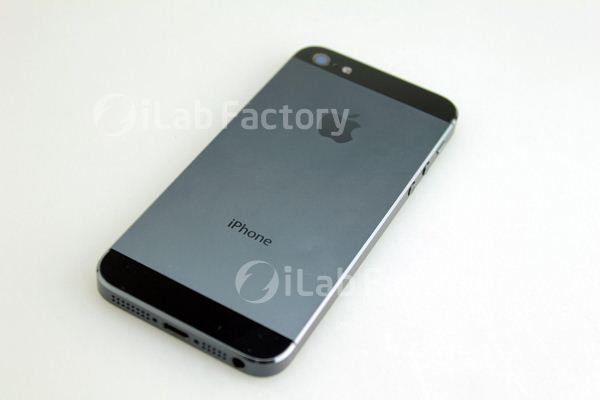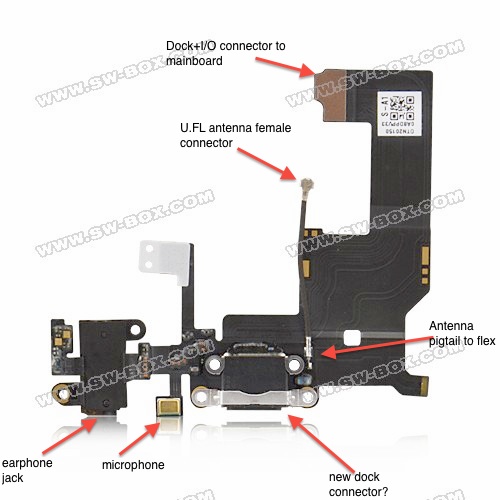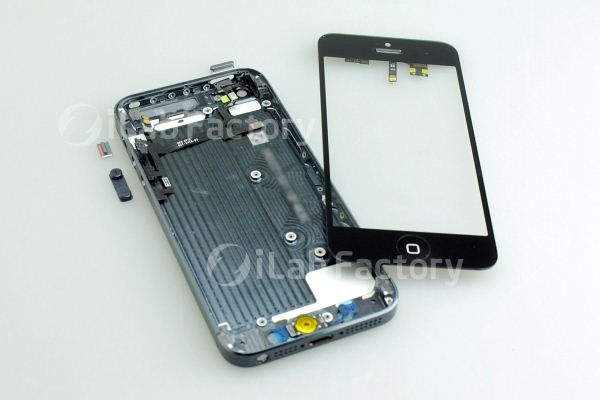Preparing for the iPhone Next: Rumors Analyzed
by Brian Klug & Anand Lal Shimpi on August 27, 2012 9:40 PM EST- Posted in
- Smartphones
- Apple
- Mobile
- iPhone
While we typically don't comment on rumors we don't know to be true at AnandTech, we often get requests to help set rational expectations ahead of major iDevice launches. The shroud of secrecy around major Apple launches can pave the way for both sensible and unrealistic conclusions.
Given the growth of Apple's iPhone/iPad devices, it has become increasingly difficult for suppliers in the chain to remain mum about any changes. Similar to how we often get early access to CPUs, motherboards and other components out of Taiwan, it has become increasingly commonplace to see leaks of iDevice components out of the big ODMs in China.
Apple is largely expected to launch its sixth iPhone next month. The historical cadence of design, SoC, and cellular changes are in the table below:
| Apple iPhone - Historical Trends | |||||||
| Release Year | Industrial Design | CPU Architecture | GPU Architecture | Cellular Architecture | |||
| iPhone | 2007 | 1st gen | ARM11 | MBX-lite | Infineon S-Gold 2 | ||
| iPhone 3G | 2008 | 2nd gen | ARM11 | MBX-lite | Infineon X-Gold 608 | ||
| iPhone 3GS | 2009 | 2nd gen | Cortex A8 | SGX-535 | Infineon X-Gold 608 | ||
| iPhone 4 | 2010 | 3rd gen | Cortex A8 | SGX-535 | Infineon X-Gold 618 in 4 GSM / Qualcomm MDM6600 in 4 CDMA | ||
| iPhone 4S | 2011 | 3rd gen | 2 x Cortex A9 | SGX-543MP2 | Qualcomm MDM6610 (MDM6600 w/ ext. trans) | ||
| iPhone Next | 2012 | ? | ? | ? | ? | ||
Trends are pretty easy to spot in the table. With the exception of the first iPhone, the industrial design appears to be on a 2-year cadence. The CPU and GPU architectures are also on the same 2-year cadence. From a silicon standpoint even the cellular architecture is trending towards the same 2-year cadence, with a few notable exceptions (e.g. GSM/CDMA iPhone 4 divide).
Based on historical trends alone it's pretty easy to conclude that we'll see a 4th generation chassis, a pair of ARM Cortex A9s and a PowerVR SGX 543MP2 under the hood. Add the assumption of LTE (a reasonable one to make) and you have a pretty believable story. It turns out the currently available evidence helps corroborate this, but let's dig through what's out there to see how this all fits.
Chassis & Display
The chassis is largely a known quantity by this point. Enough examples out of China have surfaced to support the current working theory of a 4-inch diagonal (16:9) display in a slightly taller chassis with roughly the same width. Put simply, it's a new taller aspect ratio, which also has the consequence of including a larger 4-inch, 640 x 1136 display. The result is a change only in one dimension for developers to worry about.
The other big rumored change is a move from on-cell touch sensing (which places the drive and detect ITO layers above the LCD assembly) to an in-cell touch solution. In-cell being the operative word because the drive layers are integrated into the LCD gating (or use it natively), or on the color filter layer. There's some debate about what counts as on-cell and in-cell that isn't quite settled, but ultimately what it boils down to is a thinner display stack that will contribute significantly to the reduction in overall device thickness that is rumored for the upcoming iPhone.
While the industrial design remains quite similar at a high level, there do appear to be some major changes. Where the 4 and 4S designs used front and back glass with an external metal band for support, the leaked designs out of China feature a metal unibody construction with cutouts for RF windows at top and bottom. There's enough evidence of this from the CNC machine marks visible on examples, and moreover moving to a larger form factor requires a beefier chassis.

Black regions at top and bottom are likely RF window cutouts
With top and bottom RF windows (which appear to be glass) there shouldn't be any implications on antenna performance for cellular. If you followed our coverage of the evolution of Apple's cellular antenna design from the iPhone 4 GSM, to 4 CDMA, to 4S, you'll notice that this is a clear next step, largely inheriting the top/bottom antenna split from the 4S which fully mitigated deathgrip. Interestingly enough the exterior band appears to have a different chrome finish rather than the matte stainless steel of previous designs.

Bottom flex cable, annotations ours
Other things like moving the 3.5mm headphone jack to the bottom of the device and the mini 9-pin dock connector are fairly well corroborated by leaks with components that all fit together inside the case. Interestingly enough, parts indicating the mini dock connector and relocated headphone jack have been circulating for nearly 4 months.











131 Comments
View All Comments
WaltFrench - Wednesday, August 29, 2012 - link
Overall, this was a very interesting scan of the issues.But battery life is a huge issue for some users, and important to all. So I was a bit disappointed that after all that GREAT analysis of each of the major subsystems, the contributions to battery life weren't discussed.
LTE is said to be especially battery-hungry in recent chips. Do the hypothesized baseband chips indeed gobble lots of juice? Approximately what milliwattage? And how about the expected screen tech? Screen efficiency was a major hit to power conservation on the Retina iPad; what can be expected here?
And while iOS 6 is still NDA at best, Apple's been dealing with multi-core for a long time. Any credible guesses about the software's ability to downclock the whole CPU and/or cycle individual units on and off, based on previous iOS info?
crankerchick - Wednesday, August 29, 2012 - link
People always say, "I hate to bother you but..." and then proceed to bother you. "I hate to convince you, but..." and then proceed to inconvenience you. "I don't mean to be an a jerk it..." and the proceed to be a jerk. Don't say you don't usually like to engage in rumor mill and then basically lend your advice to what rumors make sense and which ones don't. I respect our conclusions and reasoning, and even think you are probably spot on, but I do think your article kind of does the "I hate to contribute to the rumor mill but..." and the contribute to the rumor mill, albeit backed by some sound analysis. I think you are in a dangerous arena for credibility if you travel down this road.That said, I hope you will touch on your thoughts and how they measured up once the device is announced. I have no doubt some others will do this for you and then comment on any areas where you were wrong.
Toadster - Wednesday, August 29, 2012 - link
LOL - I see what you did there!hopefully it's not a 12" cube phone ;)
eanazag - Wednesday, August 29, 2012 - link
I am guessing they will include 1GB of RAM as they did in the iPad 3 so that developers will have a consist playing field going forward.What remains a question is whether they will further upgrade the camera. I think they will leave the camera untouched. The front facing camera could use a boost - especially with the Facetime over cellular coming.
Better battery life compared to the 4S would be very welcome. I have a 4 and won't touch the new iPhone unless it has 4G. I might even jump ship. I have been getting by with my 4G hotspot, but that is a pain. The charge on the hotspot is nowhere near as long as the phone.
Honestly, I have a 4 and am still pretty happy with it. I do feel at times the single core is holding back performance. My biggest wants are addressed with turn-by-turn and 4G. The turn by turn still needs to prove itself.
I am posting this from my iPad.
I am very excited to see MS entering the tablet hardware business with the Surface. I really think Dell and HP have failed miserably with their hardware thus far. They could have done a better job on Windows 7 tablets. I thought MSI took the best approach with AMD's processor and 4GB of RAM. Atom's experience on the graphics side is horrid. HP/Dell knuckleheads trying to push 2GB max devices still running Windows 7. It is still Windows 7 and the best experience is in the 4GB or more arena. Windows 8 and Surface make a lot of sense; there is one scenario that I believe Apple is beat in the tablet space and that is docking. I have a company full of users who have laptops with 2 monitors, a mouse, and keyboard. No mouse support is just ignorant on iOS and no USB drive support. I think Apple has no desire to include mouse support because the iPad may then cut into its laptop sales.
Origin64 - Thursday, August 30, 2012 - link
First of all, how does moving the headphone jack to the bottom make sense? I like to listen to music with my phone in my pocket. Were I to buy the new iPhone, which I do admit is unlikely, I would have to do that with the phone upside down.Secondly, no 1280*720 is a dealbreaker. I want 720p movies at native resolution. Same goes for NFC. I don't see myself using it in the coming months, but I might just want to have it in two years.
5Ghz wifi support is good news, although I think dual or triple channel 2.4 would be good enough for me, especially as there's usually a layer of concrete between me and my routers.
Lastly, battery life. Now I know battery life on the iPhone has always been impressive, and the move to a smaller node should emphasize that even more, but why not capitalize as much as possible on this advantage and release the iPhone with 1800+ mAH. Maybe even 2000. Surely it can be done, and it would open a whole new group of customers to Apple: those that want to charge their phones as sparsely as possible. There's plenty demand for it.
Super56K - Friday, August 31, 2012 - link
I doubt there's serious demand for crazy battery life in a smartphone. It's become ingrained in us to top off our phones each night to have a full charge for the following day. Some flagship phones already give you 2 days of moderate use.sives - Thursday, August 30, 2012 - link
Our research at Hoverkey (http://bit.ly/SWQGt7) has thrown up an interesting new twist on the iPhone 5 NFC debate set off by your article. Apple was granted a key patent last year that describes a novel design method for embedding an NFC antenna within a screen display aperture or even in the LCD screen module.This means that the iPhone 5 could have a metal unibody case AND a front-facing NFC antenna. Usability-wise this would make a lot of sense. It's much easier (and more intuitive) for a user to place their iPhone 5 against another NFC device front-first, because their hand is holding the device from the back.
OTD - Friday, August 31, 2012 - link
I agree with sives and it was a major flaw in the original article to assume that the NFC radio frequency has to be emitted from the back of the phone.Apple engineers always try to mimic human actions and behaviors when designing user interface. When you meet your friend, you hug with your friend face-to-face, not back-to-back. Therefore, if you want to send a iTune gift to your friend through the NFC interface, you two 'bump' your phones in a natural face-to-face way.
The position of the reader is consistent with the one shown in their patent on NFC.
Some one in Japan pointed out that the component in the "leaked photo" was similar to a RFC reader supplied by Toppan TDK Label:
http://www.toppan-tl.co.jp/en/sp/nfc.html
Apple may not use the same reader but the design concept could be similar. The small but thick 1-loop NFC antenna on the front. Then next layer some magnetic shielding material is required to boost up the reading distance. Behind the shielding material will be the NFC RF controller circuit board. The last one is the metallic EMI cover we saw from the photo. The small antenna loop should be able to achieve 2 to 4 cm reading distance for peer-to-peer transactions and card-mode emulation.
iwod - Thursday, August 30, 2012 - link
Been going through my head, that A6 or what ever it will be called to only have a die shrink mentioned by Anand. This simply wouldn't make sense as the performance gap will be so wide between its competitors. Apple manages to fit a 110mm2 die size A5 inside 4S, the die shrink version tested with Apple TV is only 63mm2. Surely Apple could use a little more Die Space for performance?Having similar, or zero improvement on graphics doesn't make sense either. With 30% more pixel to work with it will essentially be a downgrade rather then upgrade.
Apple dont use Krait, and QualComm doesn't offer PowerVR based GPU if even Apple liked. I took a few look and research on the web, and it seems very likely Apple will take a similar approach with TI OMAP4470. It uses a standard Cortex A9 as with Apple 's Ax SoC, uses PowerVR 544 which is a little bit more powerful then PowerVR 543 MP2. It also add featues such as CGPU which is like a special GPU for GUI, and reduce the power consumption during normal usage by 10x compare to a normal PowerVR GPU. There is also 2 Cortex M3 Core to help with basic operation like Phone Calls.
Even if Apple didn't licenses the design to use for their own. or buying the chip directly from TI, a similar approach could be done with a bit more R&D.
Since TI OMAP4470 is available soon enough, This sounds like a perfect example of what is possible or Apple A6.
gunblade - Thursday, August 30, 2012 - link
I have friends working in the SOC team and from what I heard silicon was already back in the lab before the new iPad launched. Given the schedule, 9 months should be enough for them to get most of the validation done. If there is no extra spin needed on the silicon, I think it is highly likely that they will go with Cortex A15 based A6 chip. And according the hearsay, it might be the first Rogue based mass production chip.